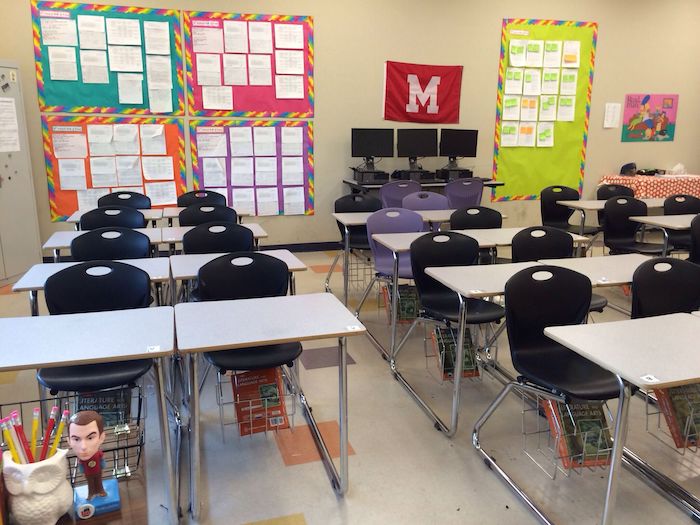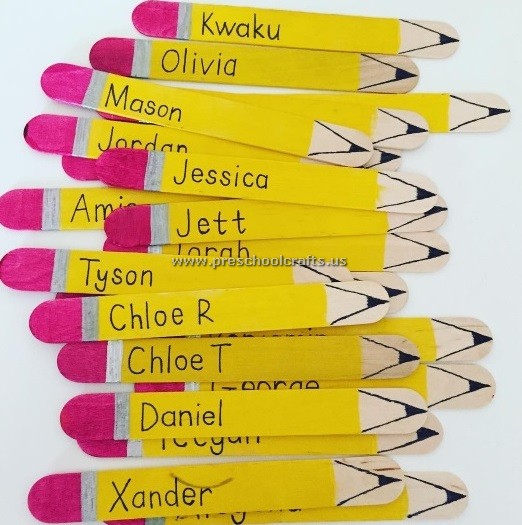Easy Way to Divide a Class Into Groups
Group work is an essential part of any student-centered classroom. Long gone are the days when kids were expected to work on assignments lonely at desks arranged in neat rows — and for good reason. The National Education Clan supports cooperative learning considering of its research-proven benefits.
Teachers who find creative ways to grouping students in the classroom tin see many positive results. When compared to competitive and private learning methods, group work tends to meet a higher increase in academic improvement, is more productive, and is more caring and supportive of classmates. It also promotes college self-esteem and better social skills.
Figuring out means to group students without creating behavior problems can be a bit challenging. However, doing so can boost your students' overall learning experiences tenfold. Here are some trending options that can take your classroom to the next level.
Easily split your classroom into groups with Classcraft.
Dissimilar ways of grouping students in the classroom
Option i: You cull
I consider myself a semi-adventurous teacher when it comes to collaborative learning. I'm creative with my lesson plans and love using technology (nosotros will talk more well-nigh tech grouping later.) I besides like to have a little control over placement. Could y'all imagine allowing all the talkers to sit together while placing all the loners in a group? That probably wouldn't work out too well.
Then there are sure assignments that require mixed grouping. I dear having students accept part in reading discussion groups. For these, you need a mix of abilities. Otherwise, the advanced kids finish too apace, and those who struggle, sit there in silence.
For a teacher-selected mix, try these ideas out:
1. Find a classroom layout that works for you lot
Earlier you can decide on a grouping selection, yous'll need to look at desk layouts and find the optimal one for grouping work. Some commonly used setups suggested by Create-Abilities include:
- The Double Due east
- Pairs (examples given after on)
- Four square (my personal favorite)
- Stadium seating
- Double horseshoe front end
- Many Us
- Groups of six or 8
2. Continents, patterns, and colors
Once y'all've decided on a layout, you can dive into other creative ways to group students in the classroom. In my last school, every classroom had a theme. Mine was travel, and then I arranged my students in groups based on the names of the continents (i.e., Africa, South America, Asia, and so on).
So, I grouped students' desks in a "four square" setup like the one below. Sometimes when teaching in minor groups, I would travel from section to section. At other times, each group would travel to a new continent to complete a stationed assignment.
If travel isn't your thing, here are another group name ideas:
- Patterns: stars, dots, stripes, plaid
- Colors: yellowish, orangish, blue, light-green
- Under the body of water: jellyfish, dolphins, turtles, sharks
- Dinosaurs: spinosaurus, triceratops, ankylosaurus, stegosaurus
- Plants: sunflowers, poppies, daisies, bluebells
- Artists: Rembrandts, Kahlos, Picassos, Monets
3. Buttons and shapes
This is a bang-up option if you lot need students to sit in a certain group considering of accommodations or behavior simply want to apace pull them into other groupings for activities. It also works for any desk layout. So, if y'all choose something other than "four foursquare" or individual groupings, buttons and shapes is a good pick.
Walking around the room while students are seated, identify a colored push (one colour per grouping) on each student'south desk-bound. Then, have the students stand and see their partners at a detail place in the room. When they finish the consignment, they return to their individual groups. This tin work with shapes, tiles, or whatever other small object that you have available.
iv. Beliefs group with tech
Even your most well-behaved student tin can benefit from this blazon of grouping. I like to mix my talkative students with the quieter ones, my "jerk worms" with my more than stoic kids, so on. This helps with classroom reward systems also.
For instance, Classcraft allows yous to group students in its classroom direction organization. Students can be warriors, mages, or healers. Assigning each group to a Classcraft team will not simply encourage positive educatee behavior but also build a sense of social connection and teamwork.
5. Partner pairs
I get it. Sometimes, rows are the simply thing that volition work. If you must (or only actually want to) group your students in traditional rows, consider two options.
The get-go is to make rows with pairs like in the example below:

Or, you could assign each student a "plow and talk" partner with whom they hold discussions during collaborative work. Past assigning these partners yourself, you can cut down on the unnecessary drama and hurt feelings that tend to happen when certain students aren't called past their peers.
Option 2: They cull
Teachers who are brave enough to let their students choose where to sit probably wouldn't read this article. So, if you're still reading, you might be wondering when, if e'er, you should allow students to group themselves. Personally, I just do this as a reward or when power/behavior does not factor into the assignment at all. If yous make up one's mind to give it a effort, consider these options:
ane. Interest groups
This works especially well with history and reading but can piece of work in other subjects as well. For example, if you lot were teaching a lesson most the Intercontinental Railroad, yous could use centers around the room. I might involve creating a steam engine blueprint (art), one might have a find-and-colour word search (reading), another might be Stalk-based (edifice a model), and and so on.
Students could make their own groups based on interests and and then switch at the sound of a timer. This allows the groups to very and for each student to have a take a chance to participate in the activities that interest them the nearly.
two. Popsicle sticks
This is a random grouping teacher favorite, but students tin use it besides. First, write each student's proper name on a popsicle stick. Then, place them in a container. Allow each pupil to pull a stick. This gives them a sense of having some say in the selection process without allowing the group selection to become a popularity competition.
Side note: I have a strict policy when information technology comes to students because others' feelings during partner selections. During the start few days of school, I explain that whatsoever "aww, man!"due south or disappointed faces during partner-picks will lead to them being assigned by me every fourth dimension.

iii. Paint swatch cloak-and-dagger election
This choice is similar to interests but can exist used with whatsoever activity. Showtime, laminate enough color swatches for everyone in the class. For example, yous might have five green, five blood-red, five bluish, etc. Have students come up in pairs to choose a color. In one case the student has made a pick, instruct them to write their first name (or initials, class numbers, etc.) on a swatch and identify it into a tub as if they were casting a secret election.
The last ii called will have fewer options to choose from, so they get the special chore of pulling out the other swatches and telling their peers how to group upwards. You can make this even more random by instructing students not to tell the others which color they chose.
4. Random name selector
Do a quick Google search for a random name selector (there are tons of these online) and enter your students' names or class numbers. Decide how many groups you want, and choose that many students to exist grouping leaders. Take each leader come to the smartboard (if yous have i) or your computer and randomly select X number of students using the random selector. Voilà! This is some other one of the many artistic ways to group students in the classroom.
5. Squad Shake
This last option is actually more random than it is teacher or student chosen, but it is still worth mentioning. Team Milk shake is a cool app that you can download on a classroom tablet. To utilise it, enter the number of groups desired, how many students are to exist in each group and the names of your students. A special educatee is selected to exist the "shaker" and is asked to milk shake the tablet. Like magic, the teams are assigned!
Which of these creative means to group students in the classroom is your favorite? We'd love to hear your feedback!
Photo credit: feliphe schiarolli / unsplash
Source: https://www.classcraft.com/blog/creative-ways-to-group-students-in-the-classroom/